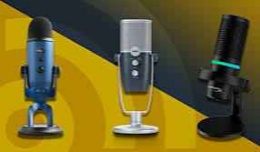When it comes to streaming on platforms like Steam, having clear and crisp audio is essential for engaging with your audience. That's where a high-quality streaming microphone comes in. A good streaming microphone not only ensures that your viewers can hear you loud and clear, but it also helps to minimize background noise and maintain a professional sound quality. Look for a microphone with features like noise cancellation, adjustable gain control, and easy plug-and-play setup. Investing in a reliable streaming microphone can take your broadcasting game to the next level and help you create content that stands out from the rest. So, whether you're a seasoned streamer or just starting out, a top-notch streaming microphone is a must-have tool for enhancing your online presence.
Demystifying the Steam Streaming Microphone: A Comprehensive Guide
The world of Steam streaming can be a thrilling adventure, allowing you to share your gameplay experiences with a vast audience. But have you ever encountered the somewhat enigmatic "Steam Streaming Microphone" in your audio settings? This guide dives deep into this virtual microphone, exploring its purpose, functionality, and the reasons behind its presence.
Understanding the Steam Link and In-Home Streaming:
Before delving into the microphone itself, let's establish the context. Steam offers a fantastic feature called "In-Home Streaming." This ingenious functionality lets you stream games from your powerful gaming PC to another device within your home network, like a Steam Link or a compatible mobile device. Essentially, your PC acts as the host, processing the game and transmitting the video and audio feed to the receiving device.
The Curious Case of the Steam Streaming Microphone:
Now, here's where the "Steam Streaming Microphone" comes into play. You might see it listed alongside your regular microphone options in your Steam settings. However, it's not a physical microphone you can plug in. It's a virtual device created by Steam to facilitate communication within the In-Home Streaming environment.
Here's the key point: The Steam Streaming Microphone doesn't actually record your voice.
So, What Does It Do?
This virtual microphone serves a specific purpose. When enabled, it allows the receiving device (Steam Link, mobile device) to capture and transmit audio back to your gaming PC. This opens up a few interesting possibilities:
Voice Chat in Local Co-op Games: Imagine playing a local co-op game on your Steam Link, but you and your friend want to use voice chat while keeping the gameplay on the big screen. This is where the Steam Streaming Microphone shines. By enabling it, you can utilize your Steam Link's microphone or the microphone on your mobile device to chat with your friend through the Steam voice chat system, even though the game itself is running on your PC.
Voice Communication with Remote Desktop Applications: If you're using a remote desktop application alongside In-Home Streaming (for instance, to access your PC desktop on the Steam Link), the Steam Streaming Microphone can enable voice chat functionalities within those applications.
Why Doesn't It Pick Up Your Voice Directly?
There are a couple of reasons why the Steam Streaming Microphone doesn' t directly capture your voice for in-game chat within streamed games:
Technical Limitations: Windows and similar operating systems categorize audio input and output as separate entities. Steam can't directly tap into the microphone input of the game itself while streaming. The Steam Streaming Microphone acts as a workaround, routing audio captured by the receiving device back to the PC for voice chat purposes.
Focus on Streamlined Streaming: Steam prioritizes a smooth, uninterrupted game streaming experience. Capturing audio directly from your PC microphone while streaming the game, video, and potentially other audio sources, could potentially introduce latency or audio processing issues. The Steam Streaming Microphone approach helps maintain a stable streaming experience.
Alternatives for In-Game Chat While Streaming:
If voice chat within the streamed game itself is your primary concern, here are alternative solutions:
Dedicated Communication Applications: Utilize applications like Discord or TeamSpeak, which run independently of the game and Steam. These platforms allow you to chat with your friends regardless of whether the game is running on your PC or streamed to another device.
Party Chat Functionality: Many games offer built-in party chat features. You can use these features to communicate with your friends within the game itself, even while streaming.
Should You Use the Steam Streaming Microphone?
The decision depends on your specific needs. Here's a breakdown:
Use It: If you're playing local co-op games on a Steam Link or mobile device and want to utilize voice chat within Steam (not necessarily within the game itself) or need voice chat functionalities in remote desktop applications used alongside In-Home Streaming, then enabling the Steam Streaming Microphone is the way to go.
Don't Use It: If your focus is on in-game voice chat during streamed gameplay, explore the alternatives mentioned earlier (Discord, party chat features). Disabling the Steam Streaming Microphone won't affect your ability to hear audio from the streamed game itself.
Troubleshooting Steam Streaming Microphone Issues:
If you're experiencing issues with the Steam Streaming Microphone, here are some troubleshooting tips:
Verify Microphone Permissions: Ensure your Steam client has permission to access your microphone in your operating system's privacy settings.
Check Default Devices: Make sure your preferred microphone is set as the default recording device in your Steam settings under "Voice" and your operating system's sound settings.
Restart Steam and Your Devices: A simple restart of your Steam client and the receiving device
Advanced Considerations and Potential Uses (Beyond Troubleshooting)
While troubleshooting covers the basics, there are some advanced considerations and potential uses for the Steam Streaming Microphone worth exploring.
Advanced Configuration:
Audio Routing Options: Some advanced users might explore tools like VoiceMeeter Banana ,to create virtual audio mixers. These tools allow for more granular control over audio routing, potentially enabling the Steam Streaming Microphone to capture your PC microphone alongside the streamed game audio, creating a combined audio feed for the receiving device. However, this approach can be complex and requires technical knowledge.
Potential Uses Beyond In-Home Streaming:
While the Steam Streaming Microphone is primarily designed for In-Home Streaming, its functionality might extend to other scenarios:
Remote Presentations: If you're using Steam Link to showcase a presentation running on your PC, enabling the Steam Streaming Microphone lets you narrate the presentation using the microphone on your Steam Link or mobile device.
Creative Applications: Some creative users might experiment with the Steam Streaming Microphone for unique audio manipulation. For instance, by combining the Steam Streaming Microphone with sounds from the streamed game on the receiving device, you could potentially create interesting audio effects. However, this is an experimental approach and may require additional software tools.
Looking Forward: Will the Steam Streaming Microphone Evolve?
The future of the Steam Streaming Microphone is uncertain. Some possibilities:
Steam Deck Integration: The Steam Deck, Valve's handheld gaming PC, integrates seamlessly with Steam's streaming features. It would be interesting to see if the Steam Streaming Microphone functionality plays a role in future updates, potentially enabling voice chat for remote co-op sessions on the Steam Deck.
Read Also: The Ultimate Gaming Keyboard Buying Guide
Integration with Third-Party Streaming Software: Perhaps future iterations of Steam or third-party streaming software might incorporate the Steam Streaming Microphone concept to create more streamlined voice chat solutions within the streaming environment.
Conclusion:
The Steam Streaming Microphone, while not a traditional microphone, serves a specific purpose within the Steam In-Home Streaming ecosystem. Understanding its functionality and limitations is crucial for optimizing your streaming experience. Whether you leverage it for local co-op voice chat or explore its potential in remote presentations, this virtual microphone offers a unique perspective on audio routing within the Steam streaming world. As technology evolves, it will be interesting to see if the Steam Streaming Microphone continues to play a role or is replaced by more versatile solutions.



